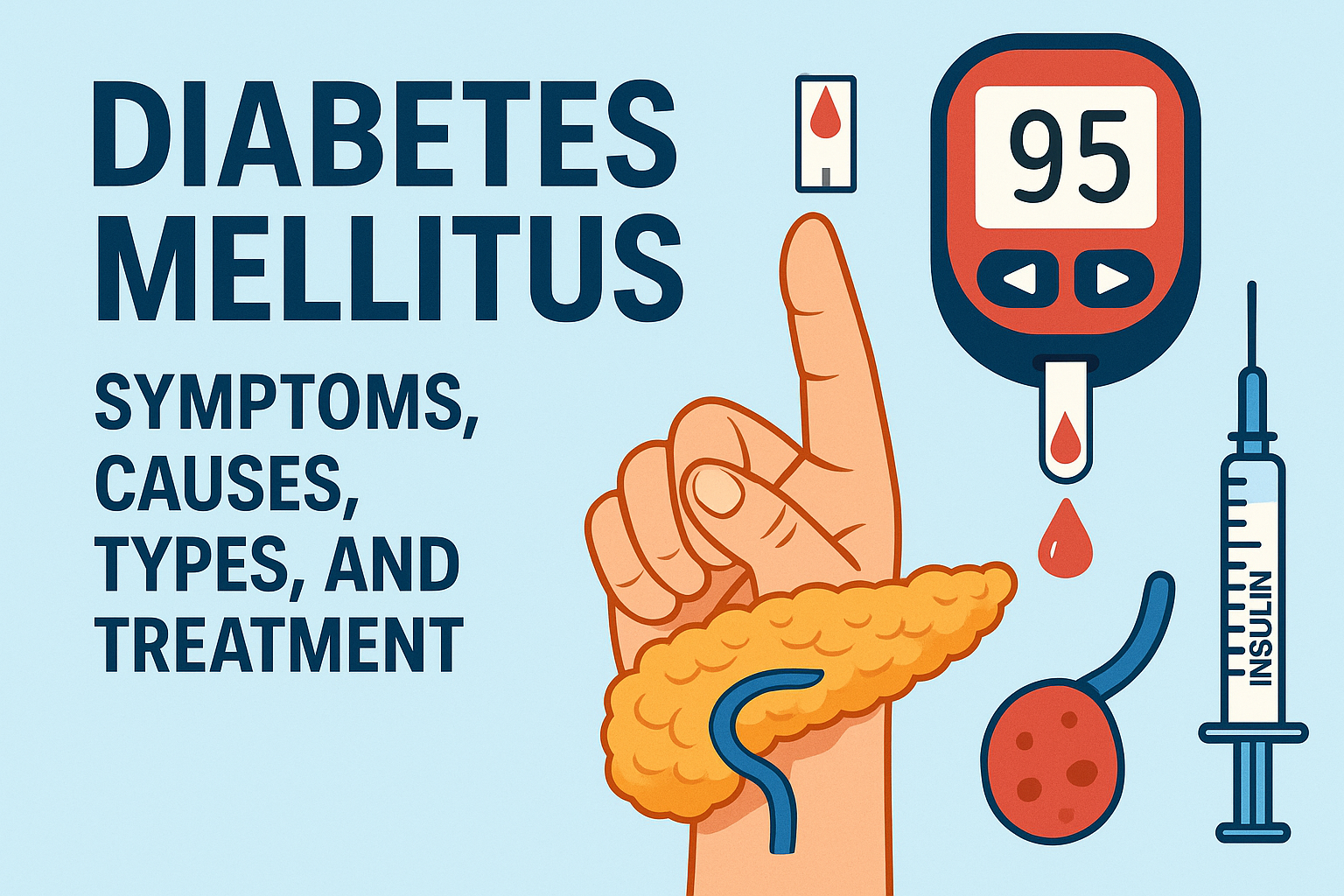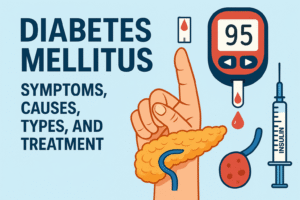What is Diabetes Mellitus and their Symptoms, Causes, Types, and Treatment

Diabetes Mellitus, commonly just called diabetes, is a chronic condition that affects millions of people around the globe. Despite how common diabetes is, a lot of people still aren’t clear on what exactly it means, how it affects their health, or what steps they can take to handle it properly. In this article, we’ll walk through everything you need to know—what causes diabetes, the various types, signs to look out for, and realistic ways to manage or even lower your chances of developing
What Exactly Is Diabetes Mellitus?
Diabetes is a condition that affects the way your body handles sugar, specifically glucose. Under normal circumstances, the pancreas produces a hormone called insulin, which helps move glucose from your blood into your cells, where it’s used for energy. But with diabetes, this process is disrupted—either your body doesn’t make enough insulin or it can’t use it properly.
Sometimes your body doesn’t produce enough insulin. Other times, it doesn’t respond to insulin properly. Either way, the result is the same: sugar builds up in your blood, which over time can cause a whole range of health problems.
The Different Types of Diabetes
There isn’t just one kind of diabetes. In fact, there are three main types—each with its own causes and treatment approaches.
1. Type 1 Diabetes
- This type is actually an autoimmune condition. The body attacks its own insulin-producing cells in the pancreas.
- Its usually diagnosed in kids or young adults, although it can develop at any age.
- Peoples with, Type 1 need daily insulin for life. since their bodies can’t make it at all.
2. Type 2 Diabetes
- This is the most common form, making up over 90% of all diabetes cases.
- It usually shows up in adults, but more and more teens and children are being diagnosed, largely due to lifestyle habits.
- In this case, the body either resists insulin or doesn’t make enough.
- It can often be managed—sometimes even reversed—with lifestyle changes and medication.
3. Gestational Diabetes
- This type happens during pregnancy and typically disappears after the baby is born.
- Even though it’s temporary, it raises the risk for Type 2 diabetes later—for both mom and child.
Recognizing the Symptoms
Diabetes often creeps in quietly, especially in the early stages. Still, some common signs include:
- Feeling unusually thirsty
- Needing to pee more than usual
- Losing weight without trying
- Feeling constantly tired
- Blurry vision
- Cuts and wounds that heal slowly
- Getting sick more often than usual
What Can Happen If It’s Not Managed
If diabetes goes untreated or is poorly controlled, it can lead to some serious health problems:
- Heart attacks or strokes
- Kidney issues, possibly even failure
- Nerve damage (often starts in the feet)
- Eye problems, including blindness
Serious infections or foot ulcers, which can sometimes lead to amputation
How to Manage—and Even Prevent—Diabetes
Managing diabetes isn’t just about taking medicine. It’s about making consistent, healthy choices every day.
For Type 1 Diabetes:
- Insulin is a must.
- Checking blood sugar regularly is part of daily life.
- Eating well and staying active helps keep things under control.
For Type 2 Diabetes:
- Losing extra weight, eating balanced meals, and exercising can make a huge difference.
- Some people need medications like metformin.
- Regular check-ups are key to tracking progress.
For Prevention:
Even if you’re at risk, there’s plenty you can do:
- Maintain a healthy body weight.
- Choose whole foods and avoid processed sugar.
- Get active—30 minutes of walking most days can help.
- Don’t smoke, and keep alcohol in check.
- If you’re in a high-risk group, get your blood sugar checked regularly.
Having Diabetes and Leading a Full Life
Although receiving a diabetes diagnosis can initially feel overwhelming, your life doesn’t have to revolve around it. People with diabetes can live active, satisfying lives if they have the appropriate resources, information, and a little help. Understanding how your body reacts and forming wholesome routines that suit you are crucial.
Wrapping It Up
There is more to diabetes mellitus than just a “sugar problem.” It’s a chronic illness that necessitates knowledge, preparation, and regular treatment. Learning about diabetes is a powerful first step, regardless of whether you’ve recently received a diagnosis, are supporting a loved one, or are just trying to stay informed.
Have thoughts or experiences to share? Drop a comment below. Let’s connect and support one another on the journey to better health.






